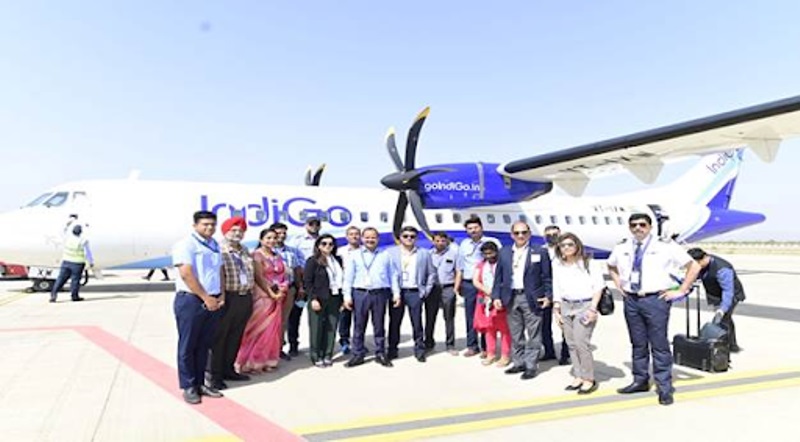 GAGAN Based LPV
GAGAN Based LPV AAI conducts flight trials using GAGAN based LPV approach Procedure at Rajasthan's Kishangarh Airport
Delhi: Airports Authority of India (AAI) Thursday successfully conducted a flight trial using GAGAN (GPS Aided GEO Augmented Navigation) based LPV Approach Procedures at Kishangarh Airport in Rajasthan, the ministry of civil aviation said Thursday.
"The successful trial is a great achievement and major milestone in the field of Air Navigation Services (ANS) in the history of the Indian Civil Aviation Sector," the ministry said
India is the first country in Asia Pacific Region to achieve such a landmark.
LPV (Localizer Performance with Vertical Guidance) permits aircraft-guided approaches that are operationally nearly equivalent to Cat-IILS, without the need for ground-based navigational infrastructure.
The service relies on the availability of GPS and GAGAN Geo Stationary Satellites (GSAT-8, GSAT-10 and GSAT-15), launched by ISRO.
GAGAN is an Indian Satellite-Based Augmentation System (SBAS) jointly developed by AAI and ISRO.
It is the first such system developed for India and neighboring countries in the equatorial region.
GAGAN System was certified by DGCA in 2015 for Approach with Vertical Guidance (APV 1) and en-route (RNP 0.1) operations.
There are only four Space-Based augmentation systems available in the world namely India (GAGAN), the US(WAAS) Europe (EGNOS), and Japan (MSAS).
Indigo Airlines using its ATR aircraft has flown an Instrument Approach Procedure (IAP) with LPV minima of 250ft, using GAGAN Service.
The tests at Kishangarh Airport were performed as part of initial GAGAN LPV flight trials along with the DGCA team on- board.
After the final approval by DGCA, the procedure will be available for the usage of commercial flights.
LPV is a Satellite Based Procedure that has been used by the aircraft for landing purposes today at Kishangarh Airport (Rajasthan).
LPV approaches will make it possible to land at airports not equipped with expensive Instrument Landing Systems, which include many small regional and local airports.
Lowering the decision height up to 250 ft provides a substantial operational benefit in poor weather and low visibility conditions.
Thus, any airport, which hitherto would require higher visibility minima, will be able to accept aircraft benefitting remote airports which are devoid of precision approach capability equipment.
A number of airports including airports under Regional Connectivity Scheme (RCS) are being surveyed for the development of GAGAN based LPV Instrument Approach Procedures so that suitably equipped aircraft can derive maximum benefit in terms of improved safety during landing, reduction in fuel consumption, reduction in delays, diversions and cancellations etc.
AAI in coordination with Indian National Centre for Ocean Information Services (INCOIS) has implemented the GAGAN Message Service (GMS) through which alert messages to fishermen, formers, and disaster-affected people will be sent on the occurrence of natural disasters, calamities, such as flood, earthquake, etc.
The additional capabilities of GAGAN are also being explored to utilize it in non-aviation fields such as Railways, Surveying, Agriculture, Power sector, Mining, etc.
Design of GAGAN procedures requires a meticulous survey of the airport environment surroundings and obstacle surfaces.
These data are correlated with the complex aircraft approach maneuvers and further simulated in software to ensure the safety of the procedure designed.
These procedures can be developed for any of the airports in India for landing without the help of an Instrument Landing System.
These types of procedures make aircraft land in low visibility conditions almost equivalent to Category-1 Instrument Landing System (ILS).
Currently Indigo (35), SpiceJet (21), Air India (15), Go First (04), Air Asia (01), and other airlines have aircraft in their fleet capable to use these LPV procedures.
Airports Authority of India has developed 22 such procedures and some are under the process of approval from DGCA for commercial flight operations.
Development of LPV procedures for all civil airports is also in progress to make the Indian civil aviation sector more self-reliant.
AAI is making all efforts for ensuring the availability, continuity, and integrity of Air Navigation services through such technological enhancement in India.
With this India becomes the first country in Asia to have a satellite-based landing procedure.
The Airports Authority of India would like to place on record its sincere appreciation to ISRO for designing and implementing the GAGAN program from 2002 onwards.
DGCA was highly proactive in ensuring the operationalization of GAGAN.
Support Our Journalism
We cannot do without you.. your contribution supports unbiased journalism
IBNS is not driven by any ism- not wokeism, not racism, not skewed secularism, not hyper right-wing or left liberal ideals, nor by any hardline religious beliefs or hyper nationalism. We want to serve you good old objective news, as they are. We do not judge or preach. We let people decide for themselves. We only try to present factual and well-sourced news.







